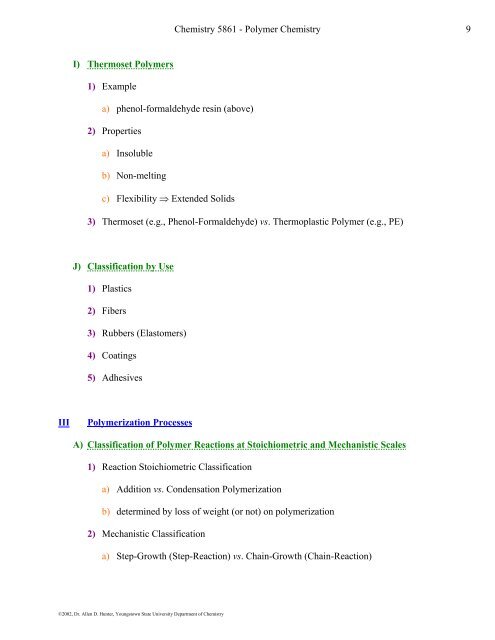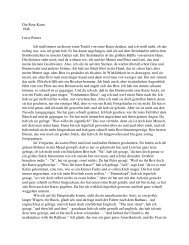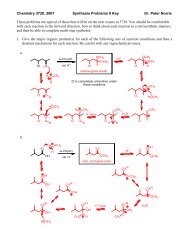Basic Principles of Polymer Chemistry - the Arts and Sciences page ...
Basic Principles of Polymer Chemistry - the Arts and Sciences page ...
Basic Principles of Polymer Chemistry - the Arts and Sciences page ...
You also want an ePaper? Increase the reach of your titles
YUMPU automatically turns print PDFs into web optimized ePapers that Google loves.
III<br />
I) Thermoset <strong>Polymer</strong>s<br />
1)<br />
2)<br />
3)<br />
Example<br />
a)<br />
a)<br />
b)<br />
c)<br />
<strong>Chemistry</strong> 5861 - <strong>Polymer</strong> <strong>Chemistry</strong> 9<br />
phenol-formaldehyde resin (above)<br />
Properties<br />
Insoluble<br />
Non-melting<br />
Flexibility ⇒ Extended Solids<br />
Thermoset (e.g., Phenol-Formaldehyde) vs. Thermoplastic <strong>Polymer</strong> (e.g., PE)<br />
J) Classification by Use<br />
1)<br />
2)<br />
3)<br />
4)<br />
5)<br />
Plastics<br />
Fibers<br />
Rubbers (Elastomers)<br />
Coatings<br />
Adhesives<br />
<strong>Polymer</strong>ization Processes<br />
A) Classification <strong>of</strong> <strong>Polymer</strong> Reactions at Stoichiometric <strong>and</strong> Mechanistic Scales<br />
1)<br />
2)<br />
Reaction Stoichiometric Classification<br />
a)<br />
b)<br />
a)<br />
Addition vs. Condensation <strong>Polymer</strong>ization<br />
determined by loss <strong>of</strong> weight (or not) on polymerization<br />
Mechanistic Classification<br />
Step-Growth (Step-Reaction) vs. Chain-Growth (Chain-Reaction)<br />
©2002, Dr. Allen D. Hunter, Youngstown State University Department <strong>of</strong> <strong>Chemistry</strong>














